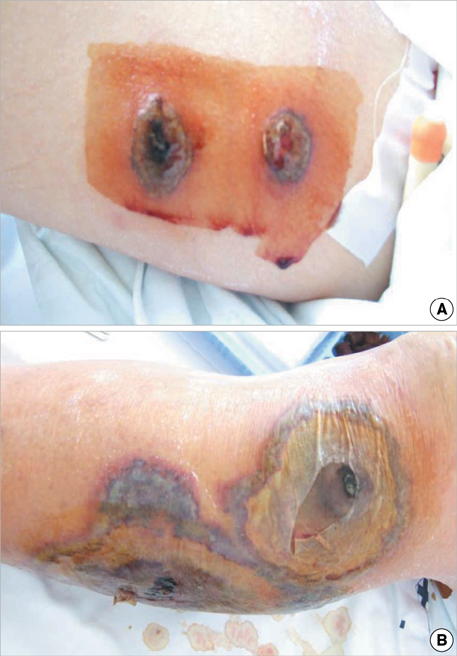J Korean Med Sci.
2010 Feb;25(2):304-308. 10.3346/jkms.2010.25.2.304.
Disseminated Mycobacterium kansasii Infection Associated with Skin Lesions: A Case Report and Comprehensive Review of the Literature
- Affiliations
-
- 1Department of Internal Medicine and AIDS Research Institute, Yonsei University College of Medicine, Seoul, Korea. seran@yuhs.ac
- KMID: 1779265
- DOI: http://doi.org/10.3346/jkms.2010.25.2.304
Abstract
- Mycobacteruim kansasii occasionally causes disseminated infection with poor outcome in immunocompromised patients. We report the first case of disseminated M. kansasii infection associated with multiple skin lesions in a 48-yr-old male with myelodysplastic syndrome. The patient continuously had taken glucocorticoid during 21 months and had multiple skin lesions developed before 9 months without complete resolution until admission. Skin and mediastinoscopic paratracheal lymph node (LN) biopsies showed necrotizing granuloma with many acid-fast bacilli. M. kansasii was cultured from skin, sputum, and paratracheal LNs. The patient had been treated successfully with isoniazid, rifampin, ethmabutol, and clarithromycin, but died due to small bowel obstruction. Our case emphasizes that chronic skin lesions can lead to severe, disseminated M. kansasii infection in an immunocompromised patient. All available cases of disseminated M. kansasii infection in non HIV-infected patients reported since 1953 are comprehensively reviewed.
MeSH Terms
-
Antitubercular Agents/therapeutic use
Clarithromycin/therapeutic use
Glucocorticoids/therapeutic use
Humans
Immunocompromised Host
Isoniazid/therapeutic use
Male
Middle Aged
Mycobacterium Infections, Nontuberculous/*diagnosis/drug therapy/immunology
*Mycobacterium kansasii/isolation & purification
Myelodysplastic Syndromes/drug therapy
Rifampin/therapeutic use
Skin Diseases, Bacterial/*diagnosis/immunology/pathology
Sputum/microbiology
Sweet Syndrome/diagnosis
Antitubercular Agents
Glucocorticoids
Rifampin
Isoniazid
Clarithromycin
Figure
Reference
-
1. Brown-Elliott BA, Wallacc RJ. Mandell GL, Bennett JE, Dolin R, editors. Infections Caused by Nontuberculosis Mycobacteria. Principle and Practice of Infectious Disease. 2004. 6th ed. Philadelphia: Elsevier;2909–2914.2. Wallace RJ Jr, Cook JL, Glassroth J, Olivier KN. Medical Section of the American Lung Association. Diagnosis and treatment of disease caused by nontuberculous mycobacteria. This official statement of the American Thoracic Society was approved by the Board of Directors, March 1997. Am J Respir Crit Care Med. 1997. 156:S1–S25.3. McGeady SJ, Murphey SA. Disseminated Mycobacterium kansasii infection. Clin Immunol Immunopathol. 1981. 20:87–98.
Article4. Breathnach A, Levell N, Munro C, Natarajan S, Pedler S. Cutaneous Mycobacterium kansasii infection: case report and review. Clin Infect Dis. 1995. 20:812–817.
Article5. Tsukamura M, Kita N, Shimoide H, Arakawa H, Kuze A. Studies on the epidemiology of nontuberculous mycobacteriosis in Japan. Am Rev Respir Dis. 1988. 137:1280–1284.
Article6. Lillo M, Orengo S, Cernoch P, Harris RL. Pulmonary and disseminated infection due to Mycobacterium kansasii: a decade of experience. Rev Infect Dis. 1990. 12:760–767.7. Yates MD, Pozniak A, Uttley AH, Clarke R, Grange JM. Isolation of environmental mycobacteria from clinical specimens in south-east England: 1973-1993. Int J Tuberc Lung Dis. 1997. 1:75–80.8. Yim JJ, Park YK, Lew WJ, Bai GH, Han SK, Shim YS. Mycobacterium kansasii pulmonary diseases in Korea. J Korean Med Sci. 2005. 20:957–960.
Article9. Komeno T, Itoh T, Ohtani K, Kamoshita M, Hasegawa Y, Hori M, Kobayashi T, Nagasawa T, Abe T. Disseminated nontuberculous mycobacteriosis caused by mycobacterium kansasii in a patient with myelodysplastic syndrome. Intern Med. 1996. 35:323–326.
Article10. Hepper NG, Karlson AG, Leary FJ, Soule EH. Genitourinary infection due to Mycobacterium kansasii. Mayo Clin Proc. 1971. 46:387–390.11. Stewart DJ, Bodey GP. Infections in hairy cell leukemia (leukemic reticuloendotheliosis). Cancer. 1981. 47:801–805.
Article12. Mead GM, Dance DA, Smith AG. Lymphadenopathy complicating hairy cell leukaemia. A case of disseminated Mycobacterium kansasii infection. Acta Haematol. 1983. 70:335–336.13. Bennett C, Vardiman J, Golomb H. Disseminated atypical mycobacterial infection in patients with hairy cell leukemia. Am J Med. 1986. 80:891–896.
Article14. Martin-Scapa C, Gomez-Criado C, Ortega-Nunez A, Bouza E. Disseminated infection caused by Mycobacterium kansasii presenting as fever of unknown origin. Eur J Clin Microbiol. 1987. 6:501–502.15. Ahmed MA. Promyelocytic leukaemoid reaction: an atypical presentation of mycobacterial infection. Acta Haematol. 1991. 85:143–145.
Article16. Delclaux C, Laederich J, Adotti F, Kleinknecht D. Fatal disseminated Mycobacterium kansasii infection in a hemodialysis patient. Nephron. 1993. 64:155–156.17. Flor A, Capdevila JA, Martin N, Gavalda J, Pahissa A. Nontuberculous mycobacterial meningitis: report of two cases and review. Clin Infect Dis. 1996. 23:1266–1273.
Article18. Kotb R, Dhote R, Garcia-Ricart F, Permal S, Carlotti A, Arfi C, Christoforov B. Cutaneous and mediastinal lymphadenitis due to Mycobacterium kansasii. J Infect. 2001. 42:277–278.
Article19. Goldschmidt N, Nusair S, Gural A, Amir G, Izhar U, Laxer U. Disseminated Mycobacterium kansasii infection with pulmonary alveolar proteinosis in a patient with chronic myelogenous leukemia. Am J Hematol. 2003. 74:221–223.20. Lai CC, Lee LN, Ding LW, Yu CJ, Hsueh PR, Yang PC. Emergence of disseminated infections due to nontuberculous mycobacteria in non-HIV-infected patients, including immunocompetent and immunocompromised patients in a university hospital in Taiwan. J Infect. 2006. 53:77–84.
Article21. Tsai CW, Wang JT, Tsai CC, Yeh KH. Disseminated Mycobacterium kansasii infection in an HIV-negative patient presenting with mimicking multiple bone metastases. Diagn Microbiol Infect Dis. 2006. 54:211–216.
Article22. Razavi B, Cleveland MG. Cutaneous infection due to Mycobacterium kansasii. Diagn Microbiol Infect Dis. 2000. 38:173–175.
Article
- Full Text Links
- Actions
-
Cited
- CITED
-
- Close
- Share
- Similar articles
-
- A Case of Mycobacterium kansasii Lymphadenitis in HIV-infected Patient
- A case of Idiopathic CD4+ T-Lymphocytopenia with disseminated Mycobacterium kansasii infection and Pulmonary alveolar proteinosis
- A Case of Pulmonary Mycobacterium kansasii Disease Complicated with Tension Pneumothorax
- A Case of Mycobacterium kansasii Pulmonary Disease Presenting as Endobronchial Lesions in HIV-Infected Patient
- A Case of Mycobacterium kansasii Cutaneous Infection in a Heart Transplant Recipient


